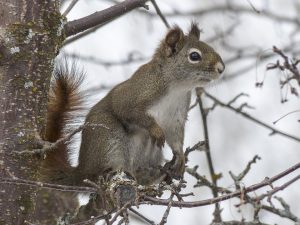 Purdue University - Extension - Forestry and Natural Resources
Purdue University - Extension - Forestry and Natural Resources
Got Nature? Blog

Most people assume, often incorrectly, that hair loss in squirrels is the result of mange, a disease caused by microscopic mites that burrow into the skin and are unseen by the naked eye. Hair loss attributed to the squirrel mange mite, Notoedres douglasi, has been reported in both fox and gray squirrels. Notoedric mange is different from sarcoptic mange. The latter, caused by the mite Sarcoptes scabiei, occurs primarily among red foxes and coyotes. Questions exist regarding the host specificity of mange mites. In light of new evidence, some pathologists now believe that sarcoptic mange mites are not as host-specific as previously thought. However, notoedric mange mites appear to be more host-specific, and don’t colonize non-hosts (like humans), although a few bites may occur. Transmission of notoedric mange to species other than squirrels has not been documented, including to canine and feline pets.
Symptoms of notoedric mange in squirrels includes loss of hair and dry, thickened and dark skin. Crust does not form on the skin in notoedric mange in squirrels like it does in sarcoptic mange in red fox. Mange is most commonly spread by direct animal to animal contact. Treatment of adult squirrels with mange is generally not recommended because reinfection from their nest is likely. An adult squirrel can survive mange if in otherwise good condition. While mange can be fatal to squirrels as a result of exposure during the winter, full recovery is often observed in squirrels.
For full article view Purdue Extension-FNR blog post, Question: I saw a squirrel with no fur on its neck, both backside and underneath. What is this?
Resources:
Indiana Animal Disease Diagnostic Laboratory
Orphaned Wildlife, Got Nature? blog, Purdue Extension-Forestry and Natural Resources
Orphaned & Injured Animals, Indiana Department of Natural Resources (IDNR)

Recent Posts
- Smooth Patch of Oak – Purdue Landscape Report
Posted: March 27, 2025 in Forests and Street Trees, Urban Forestry, Wildlife, Woodlands - Prepared for Insects Waking Up? – PLR
Posted: March 26, 2025 in Forestry, Invasive Insects, Urban Forestry, Wildlife - ID That Tree: Invasive Autumn Olive
Posted: March 24, 2025 in Forestry, Invasive Plant Species, Urban Forestry, Wildlife, Woodlands - PPDL’s 2024 Annual Report – Enhancing Plant Health
Posted: March 21, 2025 in Forestry, Invasive Insects, Invasive Plant Species, Plants, Wildlife - Rays Sharing Their Award Winning Forest – Oak Management Forestry Field Day
Posted: March 20, 2025 in Forestry, How To, Invasive Plant Species, Wildlife, Woodlands - New Directory of Professional Foresters Now Available for Indiana Woodland Owners
Posted: March 19, 2025 in Forestry, How To, Woodlands - Planting the Future: Arbor Day Seedlings for Third Graders – IN DNR
Posted: March 18, 2025 in Community Development, Forestry, Woodlands - ID That Tree: Greenbrier
Posted: March 12, 2025 in Forestry, Urban Forestry, Woodland Management Moment - Help the Hellbenders Wins Friends of Conservation Award
Posted: March 7, 2025 in Forestry, Wildlife, Woodlands - Publication – Direct Marketing Guidebook for Small/Medium-Scale Aquaculture Businesses
Posted: in Aquaculture/Fish, Aquatic/Aquaculture Resources, Publication
Archives
Categories
- Alert
- Aquaculture/Fish
- Aquatic/Aquaculture Resources
- Ask the Expert
- Christmas Trees
- Community Development
- Disease
- Drought
- Forestry
- Forests and Street Trees
- Gardening
- Got Nature for Kids
- Great Lakes
- How To
- Invasive Animal Species
- Invasive Insects
- Invasive Plant Species
- Land Use
- Natural Resource Planning
- Nature of Teaching
- Plants
- Podcasts
- Ponds
- Publication
- Safety
- Spiders
- Timber Marketing
- Uncategorized
- Urban Forestry
- Webinar
- Wildlife
- Wood Products/Manufacturing
- Woodland Management Moment
- Woodlands